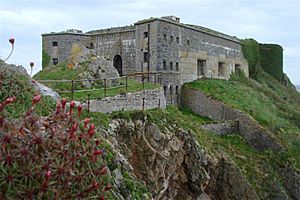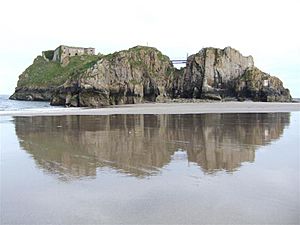St Catherine's Fort facts for kids
Quick facts for kids St Catherine's Fort |
|
|---|---|
| Part of Pembrokeshire | |
| Tenby, Wales | |

The fort stands on St Catherine's Island next to Castle Rock, Tenby.
|
|

St Catherine's Island and Fort
|
|
| Coordinates | 51°40′14″N 4°41′31″W / 51.6706°N 4.6919°W |
| Type | Palmerston Fort |
| Height | Up to 14 metres (46 ft) |
| Site information | |
| Owner | Private |
| Site history | |
| Built | 1870 |
| Materials | Limestone Granite |
St Catherine's Fort is a cool old fort built in the 1800s. It sits on St Catherine's Island right next to Tenby, a town in Pembrokeshire, Wales. This fort is a special type called a Palmerston Fort, which were built to protect Britain a long time ago.
Contents
Why Was St Catherine's Fort Built?
Back in 1859, a group called the Royal Commission on the Defence of the United Kingdom was set up by a leader named Lord Palmerston. They were worried that Napoleon III of France might try to invade Britain.
Protecting the Coastline
The main concern was protecting the important Royal Dockyard at Pembroke Dock and the safe harbor at Milford Haven. The experts thought an enemy might land on a beach in southern Pembrokeshire. Then, they could march overland to attack the naval bases.
To stop this, the plan was to build a line of coastal artillery forts along the coast. These forts would stretch from Tenby all the way to Freshwater West. They would cover all the possible landing spots. However, only St Catherine's Fort in Tenby was actually built from this big plan.
How Was the Fort Designed?
The design of St Catherine's Fort is credited to Colonel William Jervois. It's a simple, rectangular building.
Guns and Defenses
The fort has three gun rooms, called casemates, on two sides. These rooms held large RML 7-inch guns that fired through strong iron shields. On the roof, there were three more platforms for even bigger RML 9 inch 12 ton guns.
The guns facing north were meant to protect Tenby Harbour and the beach towards Saundersfoot. The guns facing south covered the beach towards Penally.
Entrance and Safety
The main entrance to the fort is on the western side, which faces the land. To get in, you had to cross a dry ditch using a drawbridge. The entrance was also protected by two special towers called caponiers. These towers had three levels with small openings, called loopholes, for soldiers to fire small arms through.
Deep inside the fort, at the basement level, were the powder magazine (where gunpowder was stored) and the shell store. The fort was designed to house about 150 soldiers.
Building the Fort
The government bought St Catherine's Island from the town of Tenby for £800 in 1866. Work started in 1867. This included clearing the land and setting up cranes. These cranes were needed for the huge job of lifting solid granite blocks onto the island.
A local builder named George Thomas from Pembroke was in charge of the construction. Officers from the Royal Engineers oversaw the project. The fort was finished by 1870 and cost £40,000. However, it didn't have its guns yet! The iron gun shields were finally put in place in 1886. But by then, a report said the big 9-inch guns were "useless."
What Happened to the Fort Later?
Over the years, St Catherine's Fort was used for many different things.
Military Training and Private Home
In 1895, the Royal Naval Reserve took control of the fort. They put a single BLC 5 inch gun there, probably for training. In 1907, the fort was no longer needed by the military and was sold to the Windsor Richards family. They turned it into a private house! The gun shields were replaced with windows, and the inside was beautifully decorated.
Even as a house, the army used the fort again during the First World War.
World War II and Beyond
During the Second World War, the government bought the fort back in 1940. The house's contents were sold off. An anti-aircraft battery was built in front of the fort to help protect against air attacks. Many different groups served there, including the Royal Marines, the Royal Artillery, a part of the Belgian Army, the Home Guard, and an Air Sea Rescue team from the RAF.
After the war, the fort was no longer used by the military. It was sold again to a local lawyer who rented it out. Famous author Norman Lewis even lived there for a while. In 1951, it became a Grade II* Listed Building. This means it's a very important historic building because it was a well-built 19th-century naval fort in a great location.
Zoo and Reopening
In 1962, the fort was sold again. In 1968, it opened as a zoo! But in 1979, the zoo moved to a new place, leaving the fort empty.
In May 2015, the Pembrokeshire Coast National Park Authority agreed to let the fort reopen to the public. They thought it would help the local economy. The plan included a nature walk, boat landings, shops, and food places, along with restoring the fort. While it was being restored, the fort was open to visitors on weekends during holiday season, depending on the tides.
In 2016, a famous TV show called Sherlock filmed an episode there. The episode was called "The Final Problem." In August 2016, the fort faced an "uncertain future" and was closed to visitors again.
St Catherine's Fort Today
The fort reopened on April 12, 2017, with the help of volunteers. It has remained open to the public as of 2020, allowing people to explore this amazing historical site.


